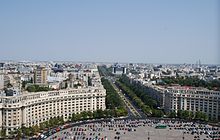Bulevardul Unirii
Bulevardul Unirii ( German Boulevard of Unity ) is the current name of the former "Boulevard of the Victory of Socialism", which the Romanian dictator Nicolae Ceaușescu had laid out in Bucharest in the 1980s . The boulevard (actually an " avenue ") is aligned with the monumental Parliament Palace (Palatul Parlamentului), formerly the "House of the People", the second largest administrative building in the world after the Washington Pentagon . It is about 3000 m long.
The construction of the palace and the postmodern aisle of the avenue leading up to it required the destruction of valuable structures. The historically significant Uranus district with its elegant villas, the fortified Mihai Vodă monastery and the operetta theater were particularly affected . The military museum and an Art Deco stadium from 1926 were also demolished. Mihai Vodă Church was moved about 100 meters. On the whole, the Paris model of Napoléon III. and Georges-Eugène Haussmann oriented monumental street openings and demolitions about 20 to 25 percent of the old town of Bucharest. Dozens of churches and several synagogues were destroyed as well as valuable historical residential buildings.
The Bulevardul Unirii is longer and one meter wider than the Avenue des Champs-Élysées . The boulevard is not very busy and has relatively little traffic, only a few shops, especially in the upper area of the Parliament Palace, were able to gain a foothold economically.
On April 23, 2012, the Romanian National Library ( Romanian Biblioteca Națională a României ), the largest library in Romania, was opened at Bulevardul Unirii number 22 .
See also
Individual evidence
Web links
- Ceausescu's cemented legacy in The Standard , Aug. 5, 2008.
- Bulevardul Unirii on the city map of Bucharest
Coordinates: 44 ° 25 ′ 34.7 " N , 26 ° 6 ′ 46.4" E


